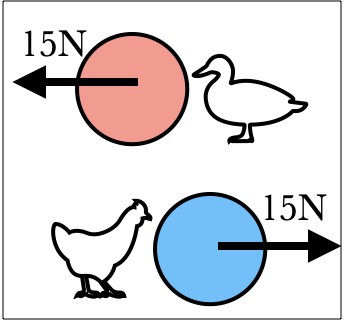7.
These are NOT Force Pairs
When trying to figure out whether two forces form a force pair, rely on the test mentioned above, of switching subject and object. Just because two forces are equal in strength and opposite in direction does not make them a force pair.
For example, consider this box sitting on the floor. The box feels two forces: weight and the normal force from the floor. Because the box is in equilibrium, the forces are balanced: equal in strength and opposite in direction. They do not form a force pair, however. Why not?
- First of all, they are different types of forces: one is weight, the other is a normal force. Force pairs are always the same type.
- More importantly, the forces are acting on the same object, and force pairs always act on different objects.

Or suppose a duck and a chicken are rolling boulders in opposite directions, and exerting the same force on the boulders. These forces are of equal strength and in opposite directions, they are of the same type, and they are even acting on different objects. However, if we describe the forces:
"The duck pushes leftward on the red boulder."
"The chicken pushes rightward on the blue boulder."
we see that they do not involve a switch of subject and object, and so are not a force pair.